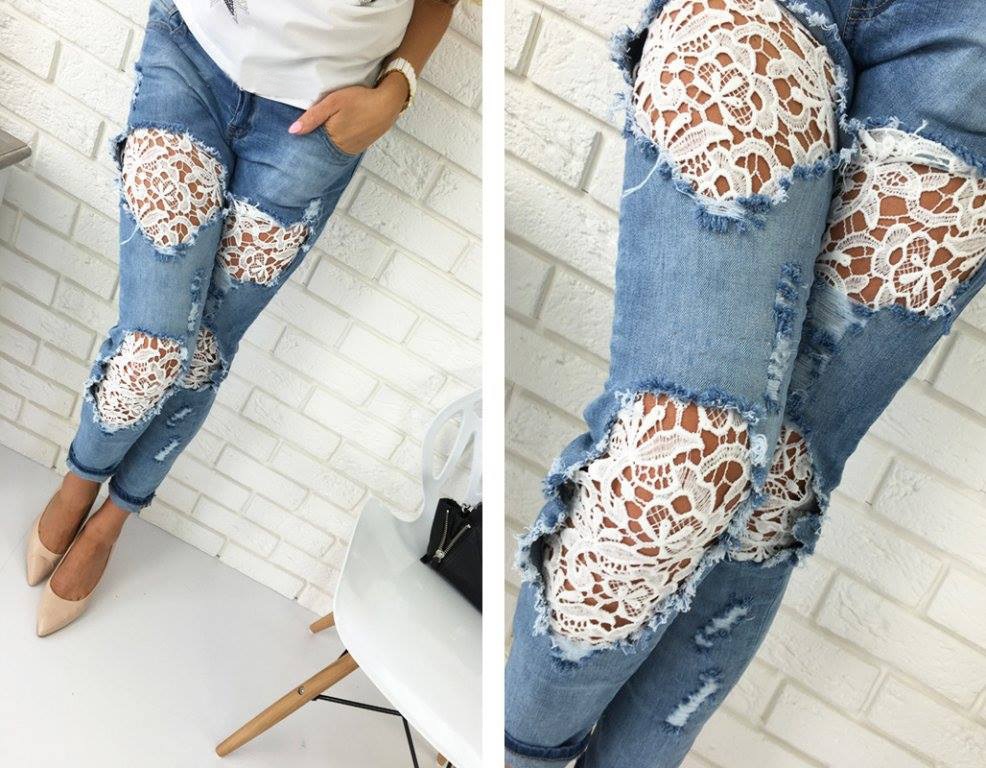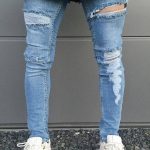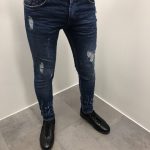Making holes and scuffs on jeans with our own hands
Frayed jeans are a stylish unisex item, without which it is impossible to imagine the wardrobe of modern girls and guys. Today it's not a problem to buy jeans with cuts and scuffs, but if you have a pair of old denim pants, you can do without shopping. We'll show you how to make holes in your jeans to make them look as good as the factory ones.
How are jeans scuffed at the factory
For processing jeans at the factory, special equipment is used, and some effects are made by hand. For example, to create scuffs, they use a sand-room - a special room where a machine directs a jet of sand under high pressure onto jeans, forming scuffs.
After the procedure, the trousers are sent to the wash and dry. A more progressive method is laser treatment, in which you can get the effect of strong aging, as well as a destroy-effect - torn jeans.
The wrinkle effect is obtained by fixing them and spraying a chemical such as varnish, which, after heat treatment, will form stylish wrinkles on the jeans.
How can you make scuffs
You can manually make holes, scuffs and scratches that look just as stylish as those made in the factory.
If you are interested in how to make scuffs on jeans at home, then you will need the things that every home has:
- metal grater;
- sandpaper or pumice;
- blade or utility knife;
- chalk for marking.

Small planks are also useful to protect the back of the legs from damage.
The effect you want will depend on the chosen method and the material of the jeans, so it is recommended that you try all the actions on an unnecessary piece of denim, and only then start the main work.
Grater
Use a float to create beautiful, torn-edged scuffs that look best on the knees. Depending on the time of exposure, you can adjust the intensity of the effect in order to slightly age the jeans or, conversely, tear them in several places. In addition to a metal grater (kitchen or foot care), you will need a plank.
Plan in advance where you want to age your jeans. Pull your trouser leg over the board and get to work: process the fabric with light movements so as not to make the slits more than necessary. Check the effect periodically, otherwise you might accidentally ruin the item.
Pumice stone, clerical knife or blade
You can make deep, even scuffs with household pumice. It is better if it is coarse.
First you need to wet your jeans, as it is recommended to work with pumice on wet denim. Then pull the legs over the planks and start rubbing the desired places with a pumice stone, adjusting the intensity of pressing. With this treatment, the effect of aging is as natural as possible. Pumice dry jeans for a trendy scratch effect.
A stationery knife or an ordinary blade is used to make cuts that can be frayed nicely by pulling out the outermost threads.
Mark the places where you want to cut the holes, and then get to work with the tool. Horizontal cuts on the front of the jeans look beautiful, and the bottom can be processed with pumice or sandpaper.
Sandpaper
Beautiful and correct scuffs at home can be done with sandpaper. Slip the pants over a plank and start sanding them to rub the fabric to the desired effect.
Using sandpaper, you can get the most natural scuffs with which the trousers will look like they have naturally aged or were purchased with them. When rubbing jeans with sandpaper yourself, keep an eye on the uniformity and intensity of the effect so that the thing looks fashionable and modern.
Wipe jeans only in standard places: on the hips, knees, on the pockets. You should not create the effect of aging where it is not typical, for example, on the front of the legs or on the sides, otherwise it will turn out to be implausible.
How to make holes in jeans with your own hands at home
In addition to scuffs, fashionable jeans often have holes of various sizes and shapes - from neat perforations to holes with ragged edges, through which bare knees are stylishly visible. Making holes in jeans with your own hands is as easy as scuffing.
Round holes
Round holes are most often placed on the knees, it is difficult for jeans to fray from frequent wear. To make them, you need scissors, with which you need to carefully cut a small round hole in the right place on the legs. Further, it remains only to disheve the products, pulling out the blue threads so that only white ones remain.
Round holes that are heavily tousled around the edges are made like this: make a horizontal cut with scissors, a knife or a razor, and then pull out the blue and white threads all over the hole. You can also leave some of the white strands intact for a trendy “scuff to hole” effect.
Holes with white threads
The trendy effect looks beautiful not only on the knees, but also on the top of the jeans. To create it, you will need a blade or scissors, as well as tweezers to pull out the blue threads.
Take your jeans and mark with chalk or pencil two horizontal stripes at a distance of 2-3 cm from each other. The distance can be more or less, depending on what size you want the hole. Make slits, and then begin to gently pull out the blue threads, leaving the white ones.If done correctly, you will end up with a rectangular hole filled with white threads.
Holes with jagged edges look more realistic, so do not try to do everything flawlessly, because leaky jeans, by definition, cannot look neat.
Lace holes
For a feminine interpretation of ripped jeans, you will need not only a standard set of tools in the form of scissors, a blade and tweezers, but also ready-made lace, crocheted or made in a factory way. For convenience, a sewing machine is also needed, although small laces can be sewn by hand.
Punch holes in the legs in a way that works best for you, fray the threads for a grungy effect, or leave the edges straight. Sew lace over the holes using a typewriter or by hand. In this way, almost the entire surface of the jeans can be processed, resulting in completely unique trousers in an elegant style.
Beautiful (neat)
You can make neat little holes with scissors or a razor by cutting small holes or horizontal slots on your jeans.
If you gently fray them around the edges, leaving the white threads, you get a slight aging effect.
This is how you can easily “age” your favorite jeans at home, making them more stylish and relevant. Each method is simple to perform and completely safe for health, and in order not to ruin your jeans, stick to a moderate upgrade and periodically evaluate the result of your work.
Video: how to make ripped jeans yourself































































